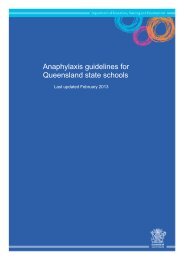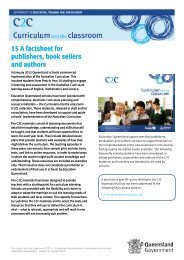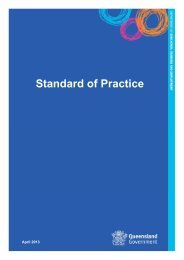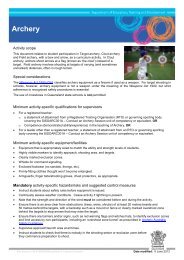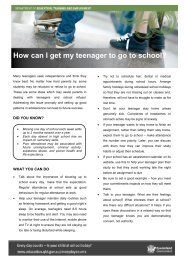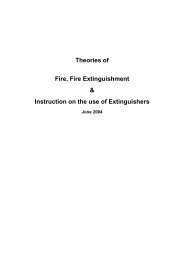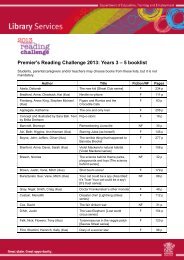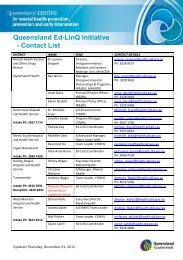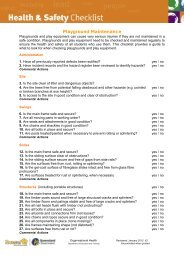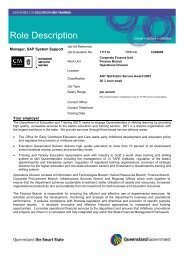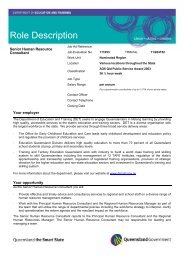1. What must be done to ensure electrical safety in schools? 2 ...
1. What must be done to ensure electrical safety in schools? 2 ...
1. What must be done to ensure electrical safety in schools? 2 ...
You also want an ePaper? Increase the reach of your titles
YUMPU automatically turns print PDFs into web optimized ePapers that Google loves.
1<strong>1.</strong> New Equipment<br />
In Australia, when the equipment is new, the supplier is deemed responsible for the <strong>in</strong>itial <strong>electrical</strong><br />
<strong>safety</strong> of the new equipment. New equipment need not <strong>be</strong> <strong>in</strong>spected or tested, however it <strong>must</strong> <strong>be</strong> <strong>in</strong>cluded<br />
<strong>in</strong> the regime of test<strong>in</strong>g and tagg<strong>in</strong>g (or used with a <strong>safety</strong> switch) as per other <strong>electrical</strong> equipment. This will<br />
<strong>ensure</strong> it is protected accord<strong>in</strong>g <strong>to</strong> the type of work for which it is used and captured with the next ‘round’ of<br />
test<strong>in</strong>g and tagg<strong>in</strong>g if appropriate.<br />
12. Can staff br<strong>in</strong>g <strong>electrical</strong> items <strong>to</strong> school?<br />
Pr<strong>in</strong>cipals have the discretion <strong>to</strong> allow staff <strong>to</strong> br<strong>in</strong>g personal <strong>electrical</strong> items on<strong>to</strong> the school site.<br />
Electrical equipment brought from home should <strong>be</strong> managed the same way as <strong>electrical</strong> items owned by<br />
school.<br />
If your school allows staff <strong>to</strong> br<strong>in</strong>g <strong>electrical</strong> equipment from home, the pr<strong>in</strong>cipal should <strong>be</strong> advised <strong>in</strong><br />
advance and the item <strong>must</strong> <strong>be</strong> visually <strong>in</strong>spected for defects by a nom<strong>in</strong>ated staff mem<strong>be</strong>r. Electrical items<br />
should then <strong>be</strong> managed accord<strong>in</strong>g <strong>to</strong> this Guide i.e. where and how it is used. Some <strong>schools</strong> implement<br />
additional processes such as requir<strong>in</strong>g items <strong>to</strong> <strong>be</strong> tested and tagged prior <strong>to</strong> them <strong>be</strong><strong>in</strong>g brought <strong>to</strong> school.<br />
13. Three phase equipment / Hard wired equipment<br />
The power available from a domestic power outlet <strong>in</strong> Australia is<br />
normally 240V of AC. The electricity available from these outlets is<br />
called s<strong>in</strong>gle phase power. This is a s<strong>in</strong>gle voltage that alternates <strong>in</strong><br />
polarity <strong>be</strong>tween positive and negative, hence the term ‘AC’ mean<strong>in</strong>g<br />
Alternat<strong>in</strong>g Current. Figure 1 shows a typical AC voltage pass<strong>in</strong>g<br />
through the positive and negative stages of one cycle, which takes onefiftieth<br />
of a second <strong>to</strong> complete. Figure 1<br />
Most small domestic appliances use s<strong>in</strong>gle phase power <strong>be</strong>cause it is easy <strong>to</strong> work with and requires only<br />
two wires, active and neutral, (plus a protective earth wire) <strong>to</strong> deliver energy <strong>to</strong> a load. However, there are<br />
some limitations <strong>to</strong> s<strong>in</strong>gle phase power. As the voltage passes through a ‘zero’ po<strong>in</strong>t twice for each cycle,<br />
there are po<strong>in</strong>ts <strong>in</strong> time when no energy is available <strong>to</strong> drive loads. This can <strong>be</strong> a problem for heavy and<br />
<strong>in</strong>dustrial loads which use a lot of power. Another problem is that s<strong>in</strong>gle phase electric mo<strong>to</strong>rs do not know<br />
which way <strong>to</strong> rotate when they start, unless special wir<strong>in</strong>g methods or mo<strong>to</strong>r-start devices are used.<br />
Three Phase Power is three simultaneous AC signals,<br />
spaced one-third of a cycle apart <strong>in</strong> a s<strong>in</strong>gle 50 Hz<br />
cycle (see figure 2). For <strong>in</strong>dustrial applications three<br />
phase mo<strong>to</strong>rs are more reliable, less expensive, run<br />
more efficiently and last many years longer than their<br />
s<strong>in</strong>gle phase counterparts.<br />
Examples of equipment that use three phase power <strong>in</strong><br />
<strong>schools</strong> <strong>in</strong>clude lathes, mill<strong>in</strong>g mach<strong>in</strong>es, shapers,<br />
compressors and some large air condition<strong>in</strong>g systems.<br />
Figure 2<br />
These items are not ‘specified <strong>electrical</strong> equipment’ and are not covered under the requirements of the<br />
Electrical Safety Regulation 2002. However, it is important <strong>to</strong> <strong>ensure</strong> these items are used safely and the risk<br />
of electric shock is prevented or m<strong>in</strong>imised.<br />
Ensure that;<br />
the equipment is secured properly <strong>to</strong> the floor <strong>to</strong> prevent any damage <strong>to</strong> wir<strong>in</strong>g or cabl<strong>in</strong>g due <strong>to</strong> slow<br />
movement or vibration of the equipment<br />
items are visually checked regularly for firm connections, damage <strong>to</strong> panels or wir<strong>in</strong>g etc<br />
Regular checks by an electrician are also recommended.<br />
Although unusual, three phase, <strong>in</strong>clud<strong>in</strong>g hard wired equipment (no plug), can <strong>be</strong> connected <strong>to</strong> <strong>safety</strong> switches.<br />
Organisational Health Unit Novem<strong>be</strong>r 2008 17



